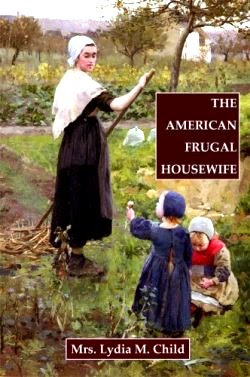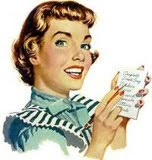”It is wise to keep an exact account of all you expend – even of a paper of pins.” The American Frugal Housewife. 1838. Written by Mrs. Child and dedicated to those who are not ashamed of economy.
 This is excellent, timeless advice. I have been keeping a “price list” for the last 10 years or so – I keep it on a computer spread sheet, but pencil and small notebook work well too.
This is excellent, timeless advice. I have been keeping a “price list” for the last 10 years or so – I keep it on a computer spread sheet, but pencil and small notebook work well too. I keep a list of the things I regularly buy, along with the last price I paid for the amount I bought. I let the spread sheet calculate the cost per pound or package so I can compare apples to oranges. There are apps available for this now, but my method is so simple I haven't bothered with them.
I usually price recipes too, especially ones I make regularly, and am surprised at the difference even 5 years has made to the price of staples, like homemade bread or pie crust.
I use my price list to check out the grocery ads for the stores near us – they come weekly in our “shopper” flier, but are also on-line, even for our small town. One of our local stores price matches the other's ads, so I often shop there and get both stores "sale prices". I can also tell if a larger quantity is a good buy at stores like Sam's, Costco or our nearby Amish stores or not. If I see a sale price on an item I don't buy regularly, Myrna is often able to tell me if it's a good sale price or not.
Lately, it's become a common practice here to price meat by the piece in the sale ads, as 5 ounce pork chops for 99¢ for example. That's about $3.18 a pound, when I can buy chops by the pound for $2.50 or a whole pork loin for $1.69 a pound, and they cut and wrap them. We wonder how many people fall for that ploy...our meat counter will sell you as little as 1/4 pound for the $2.50 price. Neither Myrna or I mind asking for small amounts of items we don't want to waste, and the butchers don't seem to mind selling us just the amount we may need.
I often jot my last best price on my shopping list so I can compare.
Lately, it's become a common practice here to price meat by the piece in the sale ads, as 5 ounce pork chops for 99¢ for example. That's about $3.18 a pound, when I can buy chops by the pound for $2.50 or a whole pork loin for $1.69 a pound, and they cut and wrap them. We wonder how many people fall for that ploy...our meat counter will sell you as little as 1/4 pound for the $2.50 price. Neither Myrna or I mind asking for small amounts of items we don't want to waste, and the butchers don't seem to mind selling us just the amount we may need.
I often jot my last best price on my shopping list so I can compare.
Keep track of the months that items you use a lot are on sale. There is often a pattern, and after awhile, you can see how much you need to buy to go until the next sale.
There are, however, a few things besides fresh produce that I don’t purchase in quantity – I simply can’t use fats and oils fast enough to keep larger “Costco” or “Sams” packages from getting rancid, for example, although I buy and freeze cheese, butter and lard. I never buy things we don’t both like – unless it’s chocolate, of course. I usually only buy enough of condiments to last until they go on sale again, often just 1 or 2 extra, just enough so I don't run out and have to make an unplanned trip to the store.
Our goal last year was to waste as little food as possible, employing the "use it up" theory, and I believe we had some success. You can see that we don’t live on just beans or dog food – we enjoy a variety of in-season foods and basics.
It's never too late to get out your grocery receipts and start keeping track of prices and weekly expenditures. Unless you shop daily, this isn't hard if you just do it regularly - I don't think it takes me more than 20 minutes a week. It isn't necessary to walk around stores writing down prices...look through store ads and compare them to your shopping list.
You may also want to start keeping track of what you throw away - what can you do to eliminate that waste?
Treat your household as a "business" - and become a better steward.
Mrs. Child's book can be read or downloaded free online:
The American Frugal Housewife Practical ideas that still work.
You may also want to start keeping track of what you throw away - what can you do to eliminate that waste?
Treat your household as a "business" - and become a better steward.
Mrs. Child's book can be read or downloaded free online:
The American Frugal Housewife Practical ideas that still work.
















Thanks for your article and download of Mrs. Child's book! I plan to track expenses closely this year to have a better understanding to budget and look for ways to save. Lately my neighbors and I carpool for grocery shopping and they study the sales so I benefit greatly. My goal too is to reduce waste. Hard to pass a deal on produce or meat, but easy to not prepare it soon enough. Another goal is to prep lunches for less excuses to drive through fast food. It was good to see your encouraging post.
ReplyDeleteThanks, Carol...
DeleteWe agree on not purchasing too many perishables...a good time to buy less, not more!